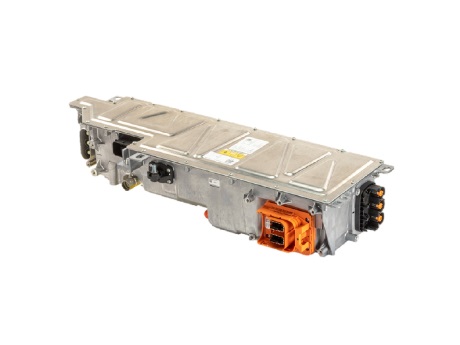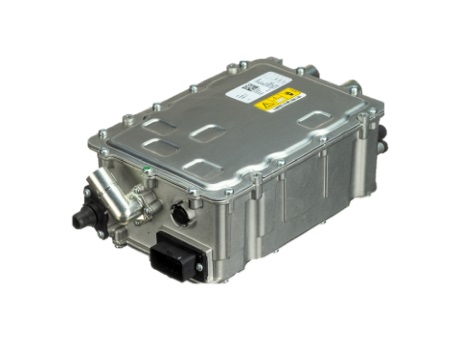Charge Mode 2 Cables
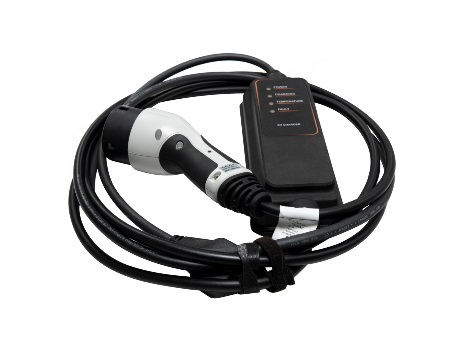
- Product Information
- Product Resources
- Enquire
- Related Products
Proven durable EV charging cables that last
Delphi Charge Mode 2 Cables are in serial production at multiple major OEMs. Tested according to automotive Standards (LV124), our proven design offers reliability and performance that exceed well beyond compliance. The In-Cable Control- and Protection Device (IC-CPD) allows drivers to safely charge their battery-powered electric vehicle (BEV) or plug-in hybrid electric vehicle (PHEV) without the need for a dedicated circuit or EV charging station.
Our robust design of the in-cable control (ICC) box make it not only drive over resistant* (acc. IEC 62196-1) but able to handle extreme temperatures ranging from -30°C (-22°F) to +50°C (122°F), all the way up to +70°C (158.0°F) in storage. With superior water sealing protection* of immersion in 1 meter, well beyond the 5cm standard* (IP67 High sealing performance (1 meter)), the IC-CPD is durable enough for anything nature throws at it.
And to ensure a service life that lasts just as long as the expected battery life of a vehicle, our IC-CPD is designed to last over 10,000 mating cycles- That adds up to a service life of 9 years if used 3 times a day!
Safe EV charging to protect you and your vehicle
When working on anything electrical, safety is our top priority. That’s why Delphi Charge Mode 2 Cables are fully compliant with the IEC 62752 standard and protect you and your vehicle from dangerous electrical faults that can cause damage, shock, fire, or worse.
Shock protection: When the vehicle charging inlet and grid socket are properly connected, all terminal interfaces and terminals are fully protected against contact. Type B RCD residual current detection (RCD) detects fault currents and disable the charging process.
(NA ONLY) Ground monitoring: IC-CPD measures the protective conductor resistance and stops the charging process if the measured value is too high.
Overheating protection: Dual thermal sensors in the grid plug and sensors inside the ICC box monitor temperature.
Short circuit protection: Short-circuit management capability, will the IC-CPD protects on short circuits at EV.
Overvoltage protection: IC-CPD protects EV from overvoltage.
| Countries* | Connector Type | Current | Charge Level | Cable Length (m/ft) | Grid plug type | Part Number |
| North America | SAE J1772 / Type 1 | 10A | Level 1 | 5.0 / 16.42 | NEMA 5-15 / 90° | PLV10001-11B1 |
| Europe | Type 2 | 10A | Level 1 | 5.0 / 16.40 | Typ E/F 90° | PLV10003-12B1 |
| UK | Type 2 | 10A | Level 1 | 5.0 / 16.42 | Typ G | PLV10005-12B1 |
| Switzerland | Type 2 | 8A | Level 1 | 5.0 / 16.44 | Typ J 90° | PLV10007-12B1 |
| Norway | Type 2 | 10A | Level 1 | 5.0 / 16.45 | Typ E/F 180° | PLV10008-12B1 |
| Denmark | Type 2 | 6A | Level 1 | 5.0 / 16.43 | Typ K 90° | PLV10010-12B1 |
| Finland | Type 2 | 8A | Level 1 | 5.0 / 16.41 | Typ E/F 90° | PLV10011-12B1 |
| Italy | Type 2 | 8A | Level 1 | 5.0 / 16.46 | CEI 23-50 / 90° | PLV10009-12B1 |
| China | GB/T | 8A | Level 1 | 5.0 / 16.42 | GB 2099 / 90° | PLV10015-12B1 |
*For a full list of countries available, please contact your Delphi representative.
| What is Level 1 AC charging? | A charging “level” in EV terminology refers to the electric power distribution type, standards, and maximum power of a charging system as defined by SAE J1772 and internationally adopted under IEC 62196-1. Sometimes referred to as “trickle charging”, level 1 charging is perfect for plug-in hybrid vehicles and offers a great alternative charging option by providing a home charging station. By using existing infrastructure, electric vehicle owners save on installation costs while still being able to fully charge their battery overnight. And because the charger is portable, it can easily be stored in any EV luggage compartment, making it perfect for short commutes, overnight charging, or an emergency charge. | A “Level 1” AC charge pulls electrical energy from the power grid via a standard 120V household outlet and capable of supplying an average maximum of 16 A and 1.92kW. The electric vehicle’s on-board charger then converts and stores this energy for the electric motor. Depending on the vehicle, level 1 charging usually takes 12 to 24 hours to get a full charge on a fully depleted battery. |
| What is mode 2 EV charging? | A charging “mode” in EV terminology refers to the mode of power delivery, control, and protective equipment of a charging system as defined by IEC 61851-1, the international standard for electric vehicle conductive charging systems. | “Mode 2" uses a cable incorporated with a protection device to connect the electric vehicle to a household socket outlets. |
Our cables use In-Cable Control- and Protection Device (IC-CPD) to provide a standard grounded power connection to residential building sockets from 100 V to 240 V 50/60 Hz (depending on the model variant) and a charging current of 6 A up to 16 A.
An alternative EV charging option for peace of mind
For drivers that suffer range anxiety- the fear that a vehicle has insufficient range to reach its destination- having a Charge Mode 2 cable available on hand can offer some peace of mind. It also ensures that your vehicle will be charged and ready for use when needed with automatic reset.
Our built-in Auto-Reset feature provides a restart in the event of a temporary power grid fault, such as excessive voltage or a brownout. The charging dock will automatically clear any error codes when the cause of the temporary error condition returns to normal and then attempt to restart the charge.
To learn more about OE quality aftermarket EV parts you can trust, contact your Delphi representative today.
The Delphi Difference
-
100 years of OE experience, supplier to the world’s top automakers
-
OE heritage and knowledge built into every aftermarket part
-
Comprehensive portfolio for a wide range of vehicles and model years
-
Streamlined SKUs for easy inventory management
-
Support through tools, tips and training

Related product resources and downloads

Resource Highlights
In this article, you will find out about the difference between a hybrid and a battery electric vehicle (H/EVs) and the advantages of each.
According to industry experts, half of the new vehicles sold globally in 2030 will be electrified in some way, meaning hybrid electric vehicles (HEV), plug-in hybrids (PHEV), and battery electric vehicles (BEV) will become increasingly commonplace on our roads. But do you know the difference between a hybrid and a battery electric vehicle (H/EVs)? And what are the advantages of each? As a leading manufacturer of advanced propulsion technology at the heart of these vehicles, we at Delphi can fill you in on the what’s what with electrified vehicles.
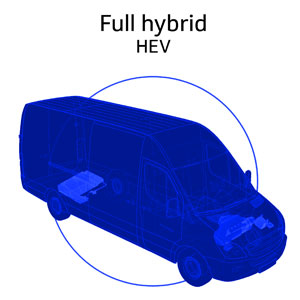
What is a hybrid car?
Unlike conventional vehicles, a hybrid car uses two different means of propulsion; an electric motor and an internal combustion engine. While the specifics will vary by type, the engine will most often be used to charge the vehicle’s battery which powers the electric motor. Another source of charge for the onboard battery is regenerative braking, or kinetic energy captured from the vehicle’s momentum when slowing down and/or braking then converted into electrical energy.
A hybrid electric vehicle (HEV) can be powered either directly by the engine, the electric motor or a combination of the two. Here, the engine is typically the main power source, with assistance provided by the motor and battery for electric-only driving at lower speeds and/or for a few miles at a time. In some hybrids, the internal combustion engine is only used for recharging the battery, while in others it drives the wheels directly, using an additional battery for some all-electric driving.
The different hybrid systems are variations of these 3 types:
1. Series hybrid
A series hybrid is a full hybrid that utilizes the electric motor for all driving, while the engine is only used to recharge the onboard battery. If the vehicle is traveling a longer distance, over 50 miles or more, the vehicle will switch over to the internal combustion engine to provide the driving power.
2. Parallel hybrid
A parallel hybrid is a full hybrid that powers the vehicle using both an internal combustion engine and an electric motor connected to a mechanical transmission. Power is distributed between the engine and motor to run at optimal operating ranges for each, making this hybrid more fuel efficient when driving long distances.
3. Mild hybrid
A mild hybrid uses a small battery and a motor-generator, to assist the powertrain, boosting the engine’s output when needed. For fuel savings, it will power down the engine when stopped or slowing down. It is the least expensive of the hybrid model types.
Whether a full hybrid or a mild hybrid, these dual-energy vehicles consume less fuel and emit fewer emissions than their gasoline engine or diesel engine equivalent, making them an attractive option for lower mileage or city driving conditions or anyone looking for better fuel economy.
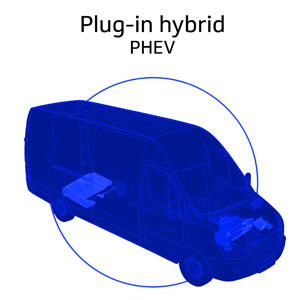
What is a plug-in hybrid car?
A plug-in hybrid vehicle (PHEV), also known as a plug-in hybrid electric vehicle or PHEV for short, is in between a hybrid and a fully electric car. As its name suggests, it is a hybrid car that can also be 'plugged in' and charged from an electric outlet, just like an electric car, as well as on the move. The main difference versus other hybrids is the higher capacity battery pack, which allows all-electric driving for longer (currently averaging between 20 to 40 miles). Once its EV range is depleted, the vehicle runs like a conventional hybrid. PHEVs give owners the benefit of all-electric driving for shorter trips and full hybrid driving range for longer distances. When used correctly, this helps to improve fuel efficiency and overall exhaust emissions.
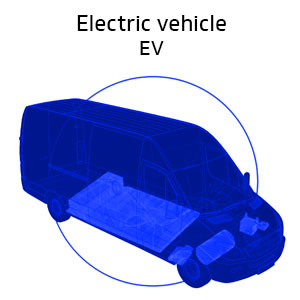
What is an electric car?
A battery electric vehicle (BEV) uses a battery-powered electric motor to power the vehicle 100 percent of the time. While it also utilizes regenerative braking, unlike hybrid vehicles, there’s no internal combustion engine to fall back on if the battery is depleted. That means you can charge or ‘refuel’ your car at home or at a charging station by plugging into an electric energy source. With no fuel, electric vehicles emit no tailpipe emissions – they don’t even have an exhaust – and are more cost effective to run.
On the downside, charging BEV batteries takes much longer than filling up a tank – several hours instead of minutes. Their driving range is also considerably less than a conventional hybrid, averaging 100 miles between charges. However, improvements in both battery technology and fast charging electrical grid infrastructure will see this become less of an issue moving forward.
So, whether a hybrid, plug-in hybrid or fully electric vehicle, the principle is the same:
Electric vehicles offload all or part of the work of the conventional combustion engine to a battery-driven motor.
To learn about the sophisticated propulsion software and systems inside, visit our Power Electronics category page.

Visit our Technician Library for access to Documents and Downloads
Get in touch
The full Delphi Power Electronics product range

Find out where to buy Delphi parts

